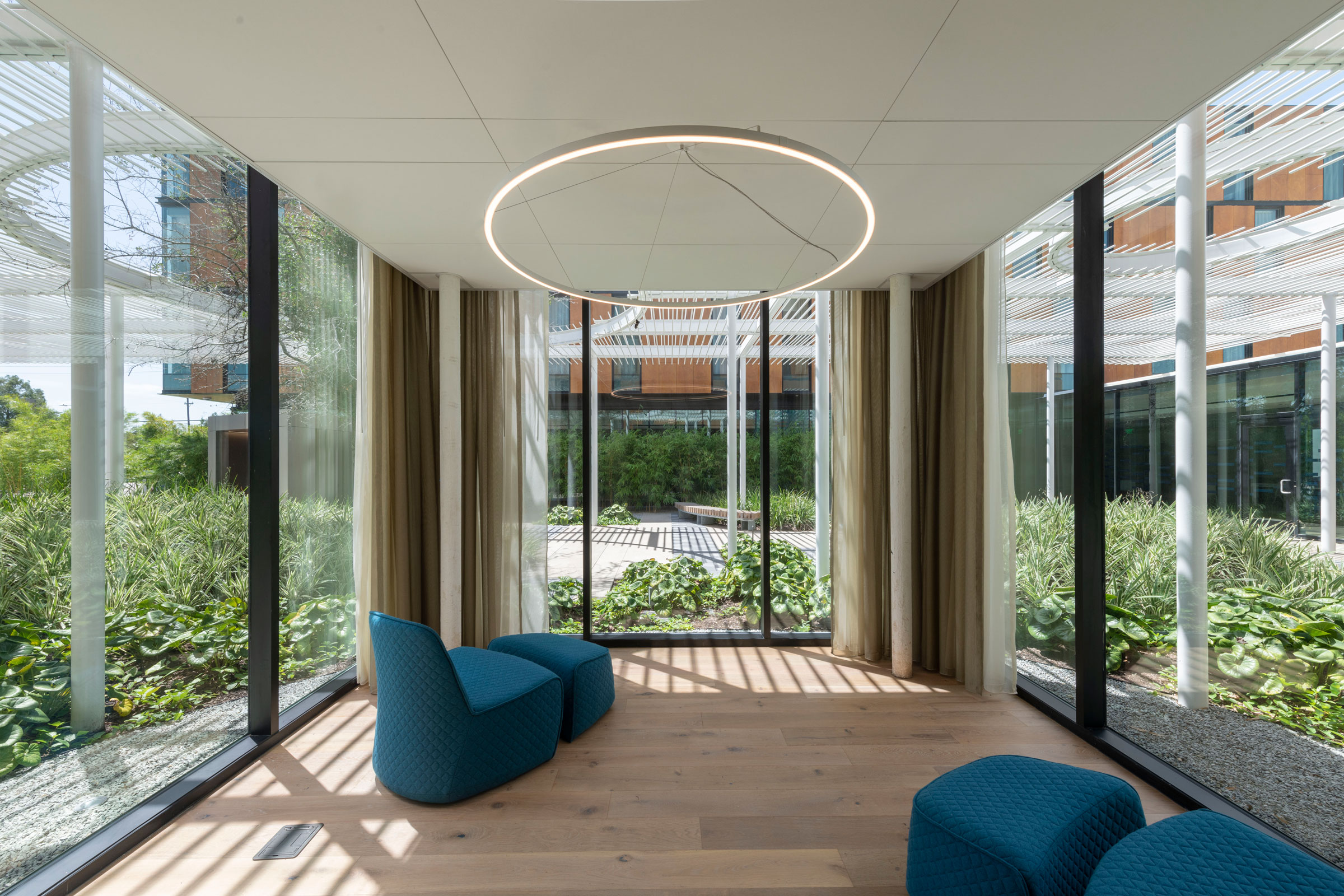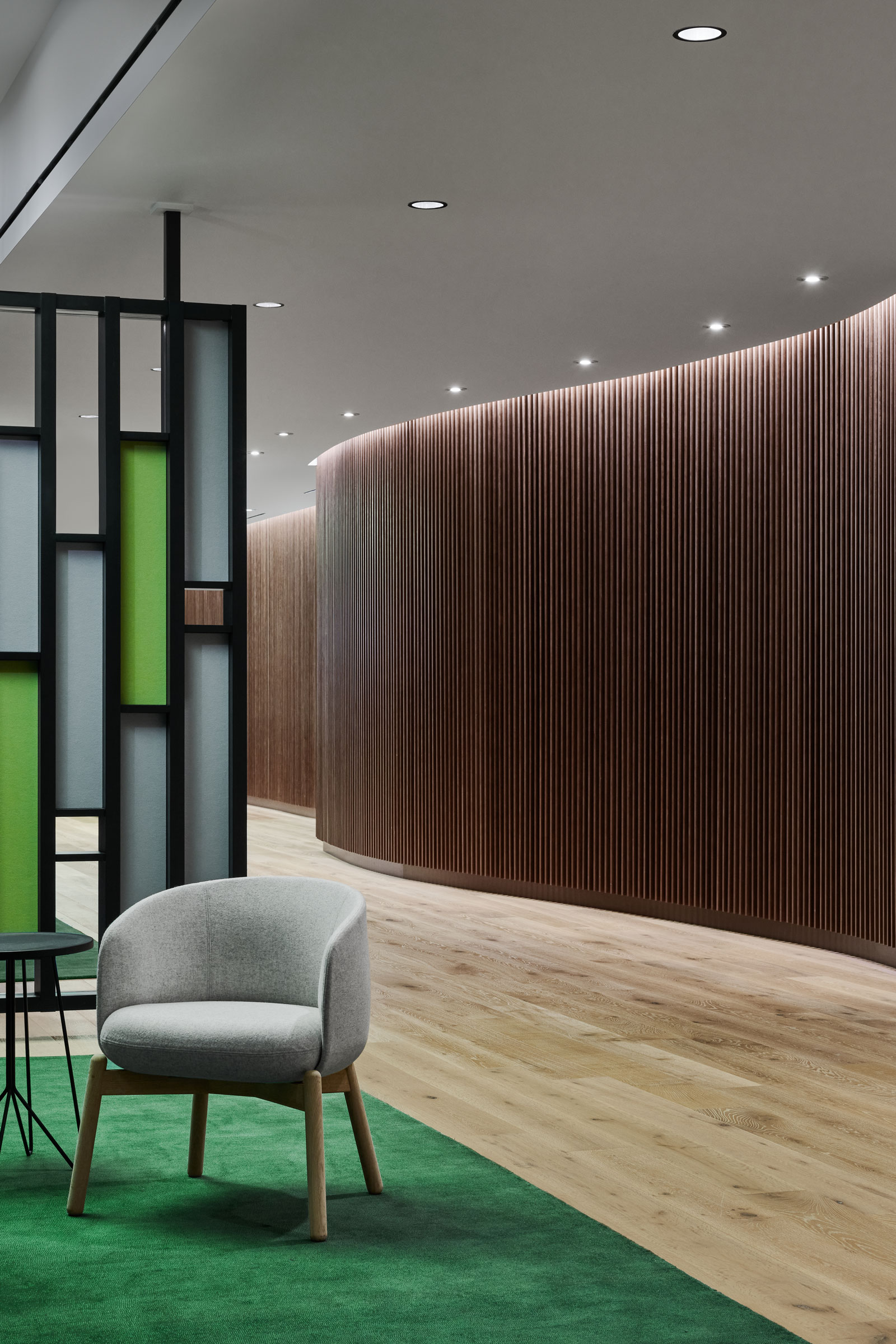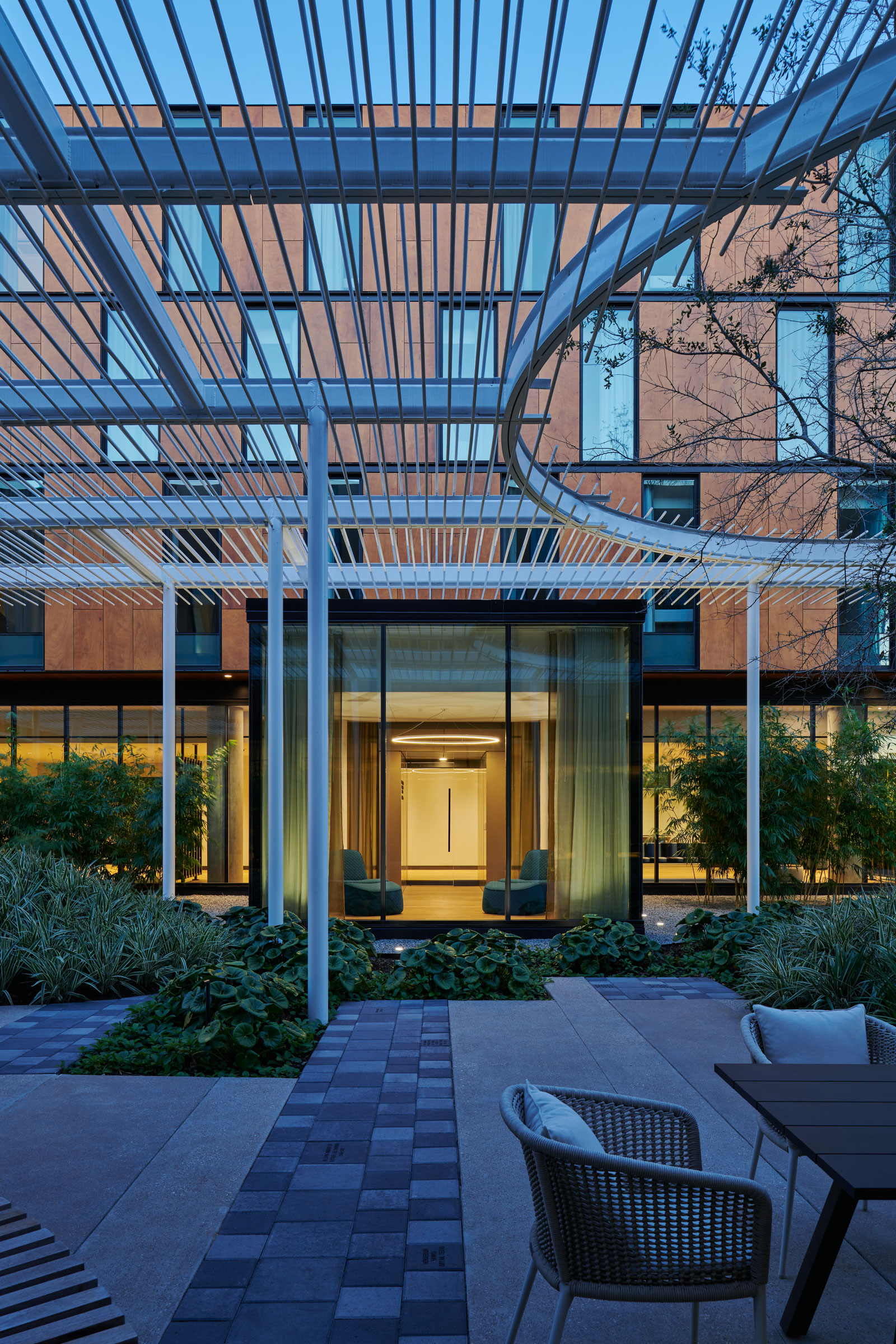Story at a glance:
- Expanding architects’ and designers’ understanding of bringing natural light into spaces
- The American Cancer Society Hope Lodge was designed using plentiful daylighting strategies.
- Kingspan Light + Air and Solatube offer many innovative solutions across project type.
Daylighting is having a renaissance. Its effect on our health and well-being has long been considered, but the data is backing that up now more than ever. Scientists at the Lighting Research Center have reported that quality exposure to daylight (as a source of interior illumination) results in improved occupant comfort, mood, and productivity and decreased stress and rates of depression. It also provides the mental and visual stimulation necessary to regulate human circadian rhythms and the production of neural transmitters like serotonin.
“We are on the cusp of transitioning from anecdotal research for the benefits of daylight to evidence-based design requirements for daylight,” says Neall Digert, vice president of innovation and market development at Kingspan Light + Air and Solatube. Digert studied structural engineering, lighting, and energy, and focused his Ph.D. on the biological and psychological impacts associated with daylight. He’s now been with the Kingspan and Solatube families—both leaders in innovative lighting solutions and more—for more than 20 years.
“It’s important to ask: How can we use daylight in a meaningful way to artfully illuminate architecture and reveal it in a fun and compelling way for the occupants while also meeting the visual requirements to ensure people can use the space effectively and consistently and be happy doing so?” Digert says.
Daylighting strategy is considered very early—from conceptual design through schematic design—at Perkins&Will, according to Tori Wickard, senior project architect at the global firm.
“Something we use a lot at Perkins&Will is ClimateStudio software,” she says. “It helps us to predict the amount of and quality of light that’s going to enter the building at various times of day or year. We can take that information and use it to optimize the design and make sure the building is going to be adequately illuminated while also minimizing energy use.”
Digert calls Perkins&Will a master of applying groundbreaking lighting strategies using ClimateStudio. Solatube worked with Solemma, the developer of ClimateStudio, to pioneer new applications of engineering data for tubular daylighting devices, or TDDs, of which Solatube is known for. “That allows us to account for the optics of optically complex systems such as a Solatube product and how those interact with the light from the daylight resource—whether it’s the sky or the sun, for any given hour of the year in any climate,” he says.
“As you predict how that light is going to be harvested, redirected, and ultimately placed in the space, ClimateStudio allows for incredibly sophisticated visualization of light within the space, accounting for any aperture type or electric lighting solution, and more importantly, to very quickly and accurately predict daylight sufficiency.”
These critical metrics are now being referenced in design guides like LEED as well as code requirements, Digert says.
Product Solutions
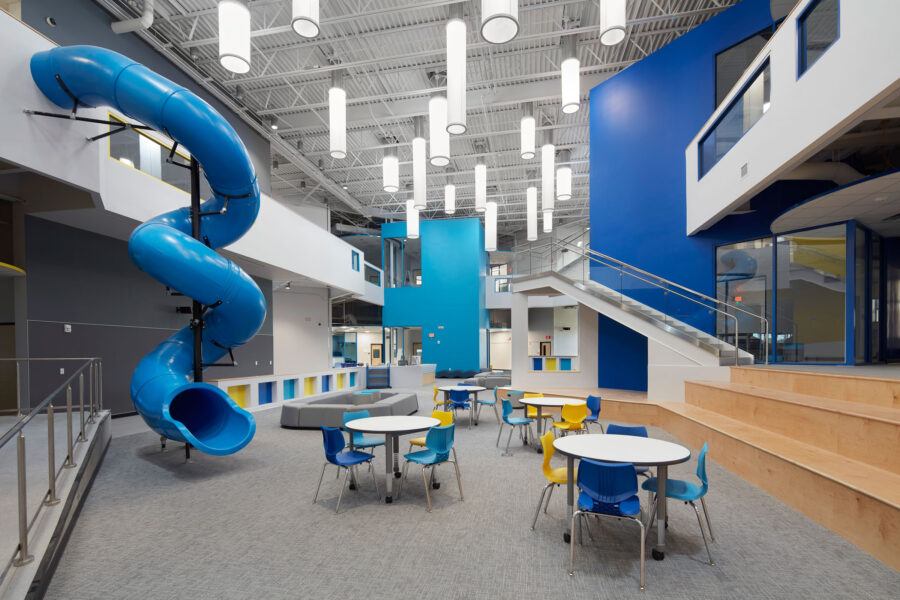
The Sunnyvale ISD Intermediate School in Texas uses Solatube TDDs with luminous shades. Photo courtesy of Solatube International
Solatube and Kingspan Light + Air continue to offer new applications so architects can choose the best solution for what they need, whether that’s based on performance, human perception, or longevity. “We can create really incredibly beautiful spaces with a level of confidence that didn’t exist just 10 years ago,” Digert says.
Solatube solutions minimize the potential for glare or contrast between the bright glazing system and perhaps darker architectural, adjacent surfaces. They also collect light from daylighting resources at head height and higher and bring that in to light the environment. They can do that using translucent or transparent systems at the vertical wall or using new technologies at the roof plane or ceiling plane to bring light in from the top, for example.
Solatube’s SkyVault is a large tubular daylighting device that works great in large commercial spaces, with tubes 29 inches in diameter and extending up to 100 feet long to fill vast spaces with natural light. Kingspan Light + Air also offers translucent wall and roof assemblies, fiberglass reinforced panels, and more. Architects can mix transparent windows with translucent wall, incorporate translucent glazings, and punch windows in a translucent wall system for great aesthetic effect.
One of Digert’s favorite creative approaches to lighting is seen at a Sunnydale Independent School District middle school in Texas. The school’s media center is in the core of the building with no windows, but when you see the space it’s gorgeously lit. “That is clearly a daylit environment,” Digert says. “It was done using Solatube tubular daylighting devices at different tube diameters to harvest daylight at the roof, drive it into the building, then deliver it through the optical diffuser.”
The architects worked with Solatube experts to craft beautiful cylinders of light for the project. “It’s like these stalactites of light that hang below the surface of the Solatube diffuser and hang below the structure of the building at different heights in different diameters in response to the size of the TDD used to harvest daylight,” Digert says. “It’s this really fun interplay of luminous chandeliers.”
Those chandeliers not only provide daylight throughout the day; they have integrated LED lights to provide nighttime illumination. They’re also fully dimmable by day using an optical dimming device. “Thinking about where daylight is going, it’s all about giving occupants control over their environment—allowing them to tune the space and the lighting solution to suit their needs or mood at any given time. In the past we couldn’t do that with fenestration. Today we can. That’s huge.”
More Than Skylights

Translucent facade with vision glass creates a modernist luminous beacon of health and fitness at the Lonetree Wellness Center. Photo courtesy of Solatube
Kingspan and Solatube offer a robust portfolio of product solutions that architects, designers, and building owners can access to choose the best solution or set of solutions to fully illuminate a space effectively given a building’s specific need, climate, or location.
We understand that buildings are dynamic, people are dynamic, and the daylighting solution needs to be dynamic
Digert has seen the industry evolve tremendously since he started his career with Solatube and now Kingspan. He started as a design consultant, working to better bring light into buildings all over the world. “In that process I discovered that every single project was basically reinventing the daylighting wheel because we didn’t have a robust set of products to allow us to highly engineer the placement of light,” he says. “A significant portion of my process was educating the architectural team on why daylight was important.”
Today Digert continues to help to define the commercial application of TDDs and other innovative solutions. He says many people have misconceptions or think daylighting is simply a skylight or big window, but those often don’t control light in the best ways. “A lot of people grew up with this notion that it’s a one size fits all solution. You have a window or you have a skylight. The reality is we’ve gone way beyond that,” he says. “We understand that buildings are dynamic, people are dynamic, and the daylighting solution needs to be dynamic.”
Daylighting for Healthier Design
- Color and comfort combine inside the Perkins&Will–designed Hope Lodge in Houston. Photo by Peter Molick
- Healthy and natural building materials, advanced mechanical and water filtration systems, and thoughtful lighting were key to Perkins&Will’s design of the Hope Lodge. Photo by Peter Molick
Daylighting has always been understood as a key strategy for achieving green, sustainable building designs and certifications like LEED, but in recent years architects have put more emphasis on using daylight to enhance the health and wellness of a space, Wickard says. “That’s where I see the primary change—moving beyond using daylight for sustainable, environmental purposes and really using it to enhance health and wellness.”
In Houston Perkins&Will employed daylighting strategies at Hope Lodge, an American Cancer Society facility for cancer patients that provides a supportive home away from home for patients and their caregivers. Structured as two residential towers wrapped around a central courtyard, the facility provides a peaceful escape complete with healing garden.
“Exposure to natural light has been proven time and time again to have numerous benefits for people, from visual comfort to psychological and neurological benefits like improving mood, reducing stress, enhancing the body’s immune response, and allowing for better sleep,” Wickard says. “The benefits you can receive from daylight are especially important for cancer patients dealing with physical and emotional stress.”
The project was designed to locate all of the programs on the building perimeter and put the circulation route around the healing garden. “As you move through the space you’re moving along this beautiful healing garden with really nice, dappled light, and that’s creating a more welcoming and comforting environment for patients and their families.”
It also creates a sense of openness and biophilic connection to help patients and their families not feel so isolated or anxious. Perkins&Will conducted a lot of research as to how they could make the building itself healthier, too. They designed the project to the WELL Building Standard and explored sunlight and vitamin D’s critical role in regulating the immune system, as it lowers the risk of chronic disease like cancer and improves mental health. “It can reduce symptoms of depression and anxiety and enhance your mental alertness and focus. Another idea the building standard addresses is how important daylight is on your body’s circadian rhythm, and how that ultimately impacts your immune response.”
In other health care spaces natural light can play a vital role in helping physicians evaluate patients more accurately, says Kevin Mereness, interior design principal at Perkins&Will in Dallas. “Natural light renders color much differently,” he says. “As they look at their skin and evaluate their health, being able to see more accurately for diagnosis is very important. There can be opportunities where they’re not just under a lamp but in spaces that have some controlled amount of natural light that can get you a better opportunity for a more accurate diagnosis.”
Daylighting in Education
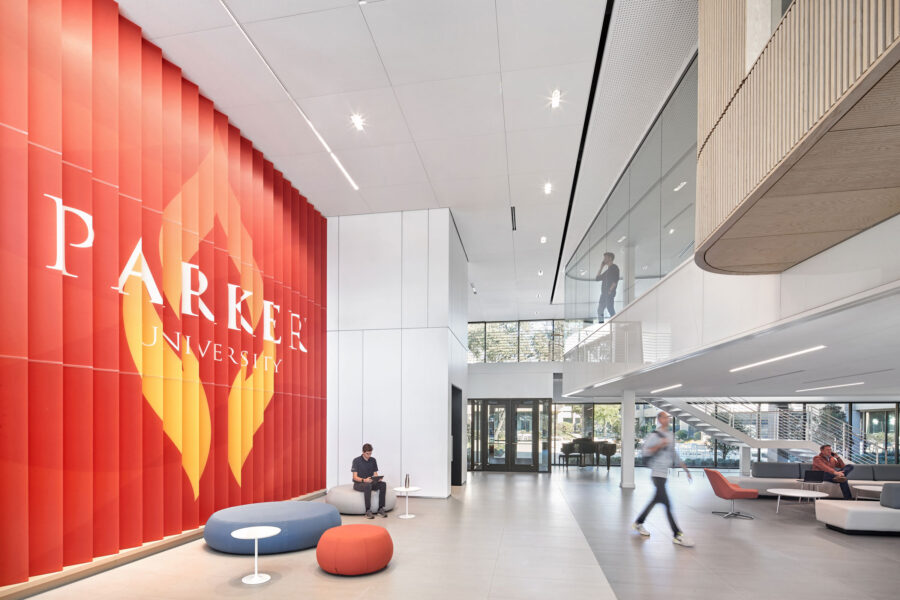
All spaces inside Parker University have access to daylight, fostering a connection with the outdoors and the broader Parker community. Photo courtesy of Perkins&Will
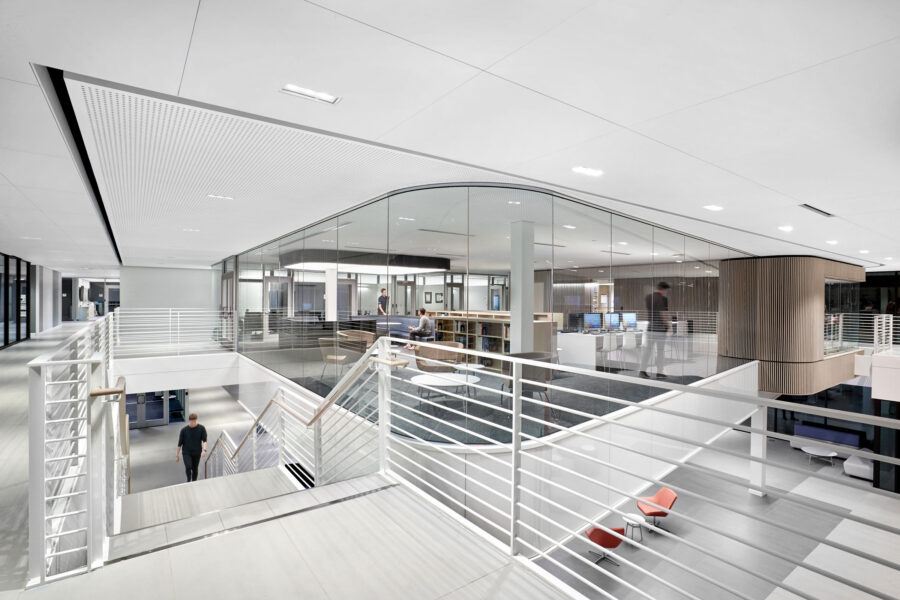
Perkins&Will used reflective surfaces in place of gypsum board to maximize natural light at Parker University in Dallas. Photo courtesy of Perkins&Will
Perkins&Will is seeing a lot of interest in innovative daylighting for educational spaces, too, especially as it relates to allowing for renewed energy and improved health of building occupants, Mereness says. “Our clients are looking for strategies to benefit well-being. Daylighting is something that, as creatives, we have to bring to the forefront of their understanding, to allow those mechanisms to be possibilities for greater design.”
Perkins&Will always assesses the client’s priorities first—from how the space is being used to what kind of light they need—before laying out a lighting strategy, whether that includes clerestory windows, tubular daylighting devices, light shelves, or other products. “There are a lot of ways you can bring daylight into a space,” Mereness says. “You have to think about different strategies. How can we integrate daylight into the center of a building, for example? And from a perimeter to the center, each area is going to require a different approach.”
At Parker University in Dallas the firm used reflective surfaces in place of gypsum board to maximize natural light. “We had back painted glass to reflect the natural light coming in from the outside. We thought about different technologies and mechanisms for how we could extend that light or create indirect light opportunities,” Mereness says. “We believe artificial light can do its job, but utilizing light sensors around the perimeter so we can maximize the amount of daylight as long as possible before the artificial light turns on was something we brought to the client.”
After a tornado destroyed half the buildings on campus, Parker University leadership saw an opportunity to modernize the campus and build cutting-edge learning environments. The central library is visible from the building’s exterior, floating within a natural light-filled two-story atrium that creates a living environment as the sun moves. All spaces have access to daylight, fostering a connection with the outdoors and the broader Parker community.
Mereness agrees using the right type of glazing and solar control as well as considering a building’s natural functions are important. “There’s sometimes a misconception that daylighting is putting as many windows in a building as you can, and you’re done. As designers we really need to bring thoughtfulness and intentionality to how we approach daylighting and how we let light infiltrate a building.”
Questions of eliminating glare and assessing thermal heat gain while maintaining sightlines are also of utmost importance. “We have to evaluate: What’s the right solution for the right situation?” Mereness says.
He says tubular daylighting devices are one great option for bringing natural light to the center of a building. Perkins&Will often turns to TDDs for K-12 projects, as those tend to have long, dark corridors. “We look to put clerestory windows in to bring in more light, and we can also bring in TDDs that have direct access to the roof, and then we can bring light down even to the first level of a multi-story building.”
While some clients think “I don’t want skylights,” he says it’s the architects’ job to educate them that there are other options for bringing light from above into the building in a cost effective way. “Clients have their money to spend and as designers we want to stretch that in the most appropriate way to bring the most value as we think about the beauty and design of our spaces. Being aware of innovative solutions that bring light further into the building is something we prioritize.”
The Future of Daylighting
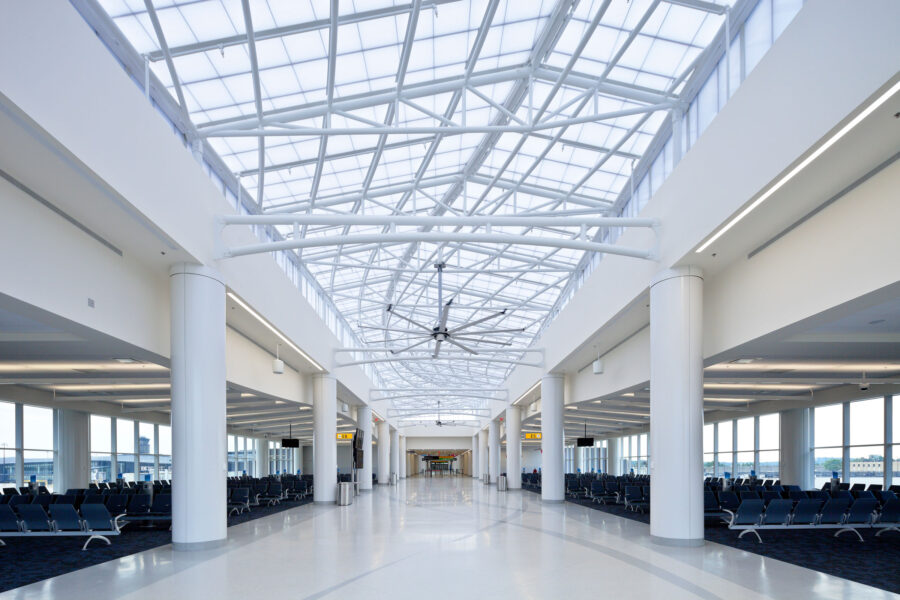
Specular architectural finishes like polished concrete at BWI Airport seen here interact with diffused light from a translucent linear architectural skylight. This creates sparkle—reinforcing the essence of what we expect from daylight. Photo courtesy of Solatube
Just as there are now building codes around ventilation, Digert expects to see more codes around daylighting, especially as data proves its importance. “We know this is good for us. All that changed in the early 2000s when the intrinsically photosensitive retinal ganglion cells (ipRGCs) were discovered.”
The ipRGCs are now proven to provide the critical input that drives hormone production and neurotransmitter production in our brains and bodies. “That vehicle is now what we understand as this critical element that defines how and what specific spectrum of light we need. Hopefully, if we do it right, it boosts and supports our critical circadian rhythm and how we function over the course of the day.”
Digert expects the conversation around lighting in buildings to evolve the same way ventilation once did. “When we think about building design we would never think of building today without some sort of ventilation. We know buildings have to be ventilated because it’s good for people’s health and comfort,” he says. “I think we’re going to start to see building codes and energy codes mandate the application of daylight as the dominant light source, with electric light as the supporting character, to provide infill when needed.”
He says, “The name of the game today is creating a building that is robustly daylit and beautifully illuminated through daylight to reveal the architecture in a really meaningful way. But also driving us biologically—making sure we’re happy, healthy, motivated, in the buildings where we live and work.”

The Richard M. Schulze Family Foundation American Cancer Society, Hope Lodge in Houston provides free lodging and amenities for cancer patients undergoing treatment. Photo by James Steinkamp

Inside Hope Lodge, designed by Perkins&Will. Photo by Peter Molick

